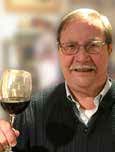Ray Spaziani
Wine Talk

Ray Spaziani
A wonderful way to welcome the new year is with some delicious sparkling wines.
Effervescence has been noted in wines since the times of the ancient Greeks and Romans. The appearance of the bubbles was not understood. Dom Pérignon, a French monk, was originally charged with the task of getting rid of the bubbles because they caused many bottles of wine to explode.
When they were making sparkling wine deliberately in the 18th century, the workers in wine cellars had to wear protective garb and masks to protect them from exploding bottles. This was to protect them from a chain reaction of spontaneously bursting bottles. It was common for them to lose between 20 and 90 percent of the wine. They did not understand carbonic gas or the mystery of fermentation. Many critics called the sparkling creations “the devil’s wine.”
My grandfather, Geno Spaziani, was a well-known home winemaker 100 years ago on Terrace Avenue in West Haven, and he made his wines using the phases of the moon to prevent effervescence.
The British were the first to appreciate sparkling wine from Champagne. They attempted to understand why the wine sparkled. Wine was transported to England in wooden wine barrels. Then the wine would be bottled for sale. English glass production was superior to that of the French, who used wood-fired ovens. The English also rediscovered the use of cork wine stoppers. The Romans had used them, but they were forgotten for centuries after the fall of the Roman Empire. During the cold winter in the Champagne region the temperatures would fall and the fermentation process would stop. This would leave some sugar and yeast that was dormant. When the wine was sent to England, the temperatures would rise again and with the superior English glass and cork stoppers the fermentation process could continue. When the wine was opened it was be bubbly. Thus British merchants were producing Champagne before the French were intentionally making it.
Fully sparkling wines are sold at five to six atmospheres of pressure in the bottle. Any wine above three is considered a full sparkling wine. These wines include Italian Spumante, German Sekt, Spanish Espumoso, and the French Cremant or Mousseux wines. Wines between 1.5 and 2.5 atmospheres include Italian Frizzante, German Spritzig, and French Petillant wines. The amount of pressure depends on the amount of sugar added during the secondary fermentation. More sugar increases the carbon dioxide bubbles, as well as the pressure of the wine.
All Champagne is sparkling wine but not all sparkling wine is Champagne. To be called Champagne it must come from the Champagne region and be produced using the Champagne method, which is double fermentation in the bottle.
There are several types of sparkling wines. There is Cava from Spain. There is Prosecco from Italy and sparkling wine from the US. Typical Champagne and most of the US sparkling wines are made from Chardonnay, Pino Noir, and Pino Meaner. Blanc du Blancs is made from Chardonnay. Blanc de Noirs is made from Pino Noir. Prosecco is made from the glera grape and has gained great popularity in the past few years. Look for DOCG on the label for the good stuff.
Pick out some sparkling wine to toast in the New Year. This past year has been difficult for all of us, and unfortunately deadly for some of us. Better times are coming. Stay safe and keep the vigil for just a few more months. We will get through this yet.
Ray Spaziani is the chapter director of the New Haven Chapter of the American Wine Society. He is on the wine tasting panel of Amenti del Vino and Wine Maker Magazine. He is an award-winning home winemaker and a certified wine educator. His fall classes were sold out but have been canceled due the coronavirus. He hopes to return to them in the spring. Email Ray with wine questions and anything wine at realestatepro1000@gmail.com.